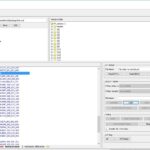Brake bleeding is a crucial maintenance task for any vehicle, ensuring optimal braking performance. A common question among car owners and DIY mechanics is whether a scan tool is necessary for this process. The answer depends on the situation and what you are trying to achieve with your brake bleed.
For routine brake fluid changes, such as those performed for regular maintenance or in preparation for track days, a scan tool is generally not essential. In these cases, manual bleeding is often sufficient. Manual bleeding effectively replaces the old brake fluid with new fluid, and since a standard fluid swap doesn’t typically introduce air into the ABS module, a scan tool isn’t required to cycle the ABS system. For vehicles with a cross-split brake system, the recommended bleeding sequence is Rear Right (RR), Left Front (LF), Left Rear (LR), and Right Front (RF). This order ensures efficient bleeding by following the flow of the brake lines.
However, a scan tool becomes indispensable when air enters the ABS (Anti-lock Braking System) module. This can happen if the brake system has been fully drained, or if air has somehow been introduced into the ABS unit itself. Air trapped within the ABS module cannot be effectively removed through manual bleeding methods alone. A scan tool with ABS bleed functionality is specifically designed to cycle the ABS solenoids and valves, thereby purging air from the module and the entire brake system. This automated bleed procedure ensures that all air pockets, especially those within the ABS module, are eliminated, restoring optimal braking performance and ABS functionality.
When using a scan tool for brake bleeding, the process typically involves following on-screen, step-by-step instructions provided by the tool. These instructions often guide you to open specific bleed screws at each wheel while the scan tool cycles the ABS system. For calipers with both inner and outer bleed screws, like those found on some front brake systems, it’s advisable to use the scan tool’s automated procedure on the inner bleed screw first. After completing the automated bleed cycles, performing a couple of manual bleed cycles on the outer bleed screw can further ensure that all old fluid and potential air pockets are removed from the caliper. This combined approach maximizes the effectiveness of the brake bleeding process, especially when using a scan tool.
In conclusion, while a scan tool isn’t always necessary for routine brake bleeding, it is crucial when dealing with air in the ABS module. For simple fluid swaps, manual bleeding is usually adequate. However, for comprehensive bleeding, particularly after system repairs or when ABS issues are suspected, a scan tool with ABS bleed capabilities is the most effective way to ensure a thorough and complete brake bleed, guaranteeing safety and optimal braking performance.

